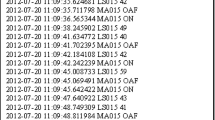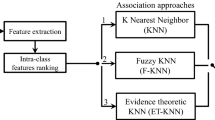Abstract
Activity recognition is beneficial for continuous health monitoring of smart-home residents, such as patients and elderly people, living in the privacy of their home. We propose an activity recognition approach apposite for a smart home environment. The observations are obtained through multiple sensors deployed at different locations within a smart home. The activities are represented by the features selected from the received observations. The inconsistent order of performing the activities, infrequent occurrences and the presence of overlapping activities make it challenging to select the features with high class representative ability and inter-class discriminative qualities. We select the key features locally within each activity class, which is least affected by the order of performance and the occurrence of other activities. Next, for association of activities, we solve the existing multi-class problem through a specifically designed binary classification with ranking solution, which learns on the correct and incorrect assignments of activities. A comparison of proposed approach with existing methods in terms of recognition accuracy is presented on publicly available ‘Kasteren’ and ‘CASAS’ datasets, representing a range of overlapping and well separated activities of daily life. Our approach tailored towards a smart home environment demonstrates a better accuracy than existing methods.



Similar content being viewed by others
References
Alemdar H, Kasteren TV, Niessen M, Merentitis A, Ersoy C (2014) A unified model for human behavior modeling using a hierarchy with a variable number of states. In: Proceedings of IEEE international conference on pattern recognition, Stockholm, pp 3804–3809
Andre D, Wolf DL (2007) Recent advances in free-living physical activity monitoring: a review. J Diabetes Sci Technol 1(5):760–767
Atallah L, Yang GZ (2009) The use of pervasive sensing for behavior profiling—a survey. Pervasive Mob Comput 5(5):447–464
Avci U, Passerini A (2014) Improving activity recognition by segmental pattern mining. IEEE Trans Knowl Data Eng 26(4):889–902
Azkune G, Almeida A, de Ipia DL, Chen L (2015) Extending knowledge-driven activity models through data-driven learning techniques. Expert Syst Appl 42(6):3115–3128
Bao L, Intille SS (2004) Activity recognition from user-annotated acceleration data. In: Proceedings of international conference on pervasive computing, Vienna, pp 1–17
Bouwstra S, Chen W, Feijs LMG, Bambang-Oetomo S (2009) Smart jacket design for neonatal monitoring with wearable sensors. In: Proceedings of IEEE international workshop on wearable and implantable body sensor networks, California, pp 162–167
Chapelle O, Keerthi SS (2010) Efficient algorithms for ranking with SVMs. Inf Retr 13(3):201–215
Chen L, Hoey J, Chris N, Cook DJ, Yu Z (2010) Sensor-based activity recognition. IEEE Trans Syst Man Cybern Part C Appl Rev 42(6):790–808
Chen C, Das B, Cook DJ (2010) A data mining framework for activity recognition in smart environments. In: Proceedings of IEEE international conference on intelligent environments, Kuala Lumpur, pp 80–83
Chen L, Nugent C, Wang H (2012) A knowledge-driven approach to activity recognition in smart homes. IEEE Trans Knowl Data Eng 24(6):961–974
Chikhaoui B, Wang S, Pigot H (2012) Activity discovery and recognition by combining sequential patterns and latent dirichlet allocation. Pervasive Mob Comput 8(6):845–862
Chinellato E, Hogg DC, Cohn AG (2016) Feature space analysis for human activity recognition in smart environments. In: Proceedings of IEEE international conference on intelligent environments, London, pp 194–197
Danaei-mehr H, Polat H, Cetin A (2016) Resident activity recognition in smart homes by using artificial neural networks. In: Proceedings of IEEE international conference on smart grid congress and fair (ICSG), Istanbul
Dhirl CS, Iqbal N, Lee SY (2007) Efficient feature selection based on information gain criterion for face recognition. In: Proceedings of IEEE international conference on information acquisition, Seogwipo-si, pp 523–527
Ermes M, Parkka J, Mantyjarvi J, Korhonen I (2011) Detection of daily activities and sports with wearable sensors in controlled and uncontrolled conditions. IEEE Trans Inf Technol Biomed 12(1):20–26
Fahad LG, Tahir SF, Rajarajan M (2014) Activity recognition in smart homes using clustering based classification. In: Proceedings of IEEE international conference on pattern recognition, Stockholm, pp 1348–1353
Fahad LG, Ali A, Rajarajan M (2015a) Learning models for activity recognition in smart homes. In: Proceedings of international conference on information science and applications, Pattaya
Fahad LG, Khan A, Rajarajan M (2015b) Activity recognition in smart homes with self verification of assignments. Neurocomputing 149:1286–1298
Fahad LG, Tahir SF, Rajarajan M (2015c) Key features identification for activity recognition in smart homes. In: Proceedings of IEEE international conference on communications, London
Fang H, He L, Si H, Liu P, Xie X (2014) Human activity recognition based on feature selection in smart home using back-propagation algorithm. ISA Trans 53(5):1629–1638
Fleury A, Vacher M, Noury N (2010) Svm-based multimodal classification of activities of daily living in health smart homes: sensors, algorithms, and first experimental results. IEEE Trans Inf Technol Biomed 14(2):274–283
Forkan ARM, Khalil I, Tari Z, Foufou S, Bouras A (2015) A context-aware approach for long-term behavioural change detection and abnormality prediction in ambient assisted living. Pattern Recognit 48(3):628–641
Forman G (2003) An extensive empirical study of feature selection metrics for text classification. J Mach Learn Res 3:1289–1305
Garcia CG, Nunez-Valdez ER, Garcia-Diaz V, G-Bustelo BCP, Lovelle JMC (2018) A review of artificial intelligence in the internet of things. Int J Interact Multimed Artif Intell 4(3):7–10
Gu T, Wang L, Chen H, Tao X, Lu J (2011) Recognizing multiuser activities using wireless body sensor networks. IEEE Trans Mob Comput 10(11):1618–1631
Hoey J, Plotz T, Jackson D, Monk A, Pham C, Olivier P (2011) Rapid specification and automated generation of prompting systems to assist people with dementia. Pervasive Mob Comput 7(3):299–318
Hoque E, Stankovic J (2012) Aalo: activity recognition in smart homes using active learning in the presence of overlapped activities. In: Proceeding of IEEE international conference on pervasive computing technologies for healthcare, San Diego, pp 139–146
Huang PC, Lee SS, Kuo YH, Lee KR (2010) A flexible sequence alignment approach on pattern mining and matching for human activity recognition. Exp Syst Appl 37(1):298–306
Jalal A, Kamal S (2018) Improved behavior monitoring and classification using cues parameters extraction from camera array images. Int J Interact Multimed Artif Intell 5(7):1–8
Kasteren TV, Noulas A, Englebienne G, Krose B (2008) Accurate activity recognition in a home setting. In: Proceeding of international conference on ubiquitous computing, Seoul, pp 1–9
Kasteren TV, Englebienne G, Krose B (2011) Hierarchical activity recognition using automatically clustered actions. In: Proceedings of international conference on ambient intelligence, Amsterdam, pp 82–91
Kushwah A, Kumar S, Hegde RM (2015) Multi-sensor data fusion methods for indoor activity recognition using temporal evidence theory. Pervasive Mob Comput 21(1):19–29
Lu CH, Ho YC, Chen YH, Fu LC (2013) Hybrid user-assisted incremental model adaptation for activity recognition in a dynamic smart-home environment. IEEE Trans Hum Mach Syst 43(5):421–436
Lu L, Zhan L, Yi-Ju CQ (2017) Activity recognition in smart homes. Multimed Tools Appl 76(22):2420324220
Mckeever S, Ye J, Coyle L, Bleakley C, Dobson S (2010) Activity recognition using temporal evidence theory. J Ambient Intell Smart Environ 2(3):253–269
Mshali H, Lemlouma T, Magoni D (2018) Adaptive monitoring system for e-health smart homes. Pervasive Mob Comput 43:1–19
Nazerfard E, Das B, Holder LB, Cook DJ (2010) Conditional random fields for activity recognition in smart environments. In: Proceedings of ACM International Health Informatics Symposium, Washington, pp 282–286
Okeyo G, Chen L, Wang H (2014) Combining ontological and temporal formalisms for composite activity modeling and recognition in smart homes. Fut Gen Comput Syst 39:29–43
Ordonez FJ, Iglesias JA, de Toledo P, Ledezma A, Sanchis A (2013) Online activity recognition using evolving classifiers. Exp Syst Appl 40(4):1248–1255
Peng H, Long F, Ding C (2005) Feature selection based on mutual information criteria of max-dependency, max-relevance, and min-redundancy. IEEE Trans Pattern Anal Mach Intell 27(8):1226–1238
Rashidi P, Cook DJ (2009) Keeping the resident in the loop: adapting the smart home to the user. IEEE Trans Syst Man Cybern Part A 39(5):949–959
Rashidi P, Cook DJ, Holder LB, Schmitter-Edgecombe M (2011) Discovering activities to recognize and track in a smart environment. IEEE Trans Knowl Data Eng 23(4):527–539
Rialle V, Duchene F, Noury N, Bajolle L, Demongeot J (2002) Health smart home: information technology for patients at home. Telemed J e-Health 8(4):395–409
Riboni D, Pareschi L, Radaelli L, Bettini C (2011) Is ontology-based activity recognition really effective? IEEE international workshops on pervasive computing and communications, Seattle, pp 427–431
Rieping K, Englebienne G, Krose B (2014) Behavior analysis of elderly using topic models. Pervasive Mob Comput 15:181–199
Rifkin RM, Klautau A (2004) In defense of one-vs-all classification. J Mach Learn Res 5:101–141
Sebbak F, Chibani A, Amirat Y, Mokhtari A, Benhammadi F (2013) An evidential fusion approach for activity recognition in ambient intelligence environments. Robot Auton Syst 61(11):1235–1245
Shin JH, Lee B, Park KS (2011) Detection of abnormal living patterns for elderly living alone using support vector data description. IEEE Trans Inf Technol Biomed 15(3):438–448
Singla G, Cook DJ, Schmitter-edgecombe M (2008) Incorporating temporal reasoning into activity recognition for smart home residents. In: Proceedings of the AAAI workshop on spatial and temporal reasoning, Chicago, pp 53–61
Sorensen S, Duberstein P, Gill D, Pinquart M (2006) Dementia care: mental health effects, intervention strategies, and clinical implications. Lancet Neurol 5(11):961–973
Stikic M, Larlus D, Ebert S, Schiele B (2011) Weakly supervised recognition of daily life activities with wearable sensors. IEEE Trans Pattern Anal Mach Intell 33(12):2521–2537
Tapia EM, Intille SS, Larson K (2004) Activity recognition in the home using simple and ubiquitous sensors. Pervasive Comput 3001:158–175
Tolstikov A, Hong X, Biswas J, Nugent C, Chen L, Parente G (2011) Comparison of fusion methods based on dst and dbn in human activity recognition. J Control Theory Appl 9(1):18–27
Wang Z, Jiang M, Hu Y, Li H (2011) An incremental learning method based on probabilistic neural networks and adjustable fuzzy clustering for human activity recognition by using wearable sensors. IEEE Trans Inf Technol Biomed 16(4):691–699
Zhang M, Sawchuk AA (2011) A feature selection-based framework for human activity recognition using wearable multimodal sensors. In: Proceedings of the international conference on body area networks, Beijing
Author information
Authors and Affiliations
Corresponding author
Additional information
Publisher’s Note
Springer Nature remains neutral with regard to jurisdictional claims in published maps and institutional affiliations.
Rights and permissions
About this article
Cite this article
Tahir, S.F., Fahad, L.G. & Kifayat, K. Key feature identification for recognition of activities performed by a smart-home resident. J Ambient Intell Human Comput 11, 2105–2115 (2020). https://doi.org/10.1007/s12652-019-01236-y
Received:
Accepted:
Published:
Issue Date:
DOI: https://doi.org/10.1007/s12652-019-01236-y




